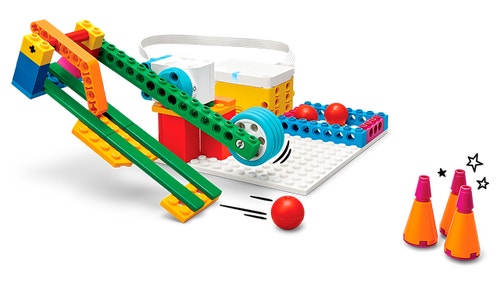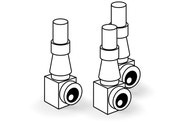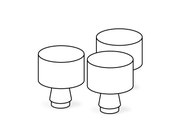SPIKE™ Essential
Bowling Fun
Have fun with Daniel’s bowling game! Can you get a strike?
30-45 min.
Beginner
Grades 3-5

Prepare
- Review the Bowling Fun lesson in the LEGO® Education SPIKE™ App.
- If necessary, pre-teach these related vocabulary words: force, modify, potential energy, and ramp.
- Consider the abilities and backgrounds of all your students. Differentiate the lesson to make it accessible to everyone. See the Differentiation section below for suggestions.
- If time allows, plan and facilitate the language arts extension. See the Extension section below for more information.
Engage
(Whole Class, 5 Minutes)
- Facilitate a quick discussion about the outcomes of the changes in energy that occur when objects collide.
- Talk with your students about what happens when two or more objects collide (e.g., in bowling, baseball, golf).
- Ask questions, like: What will you see when two objects collide? What do you think happens to the energy of the objects when they collide?
- Introduce your students to the story’s main characters and the first challenge: bowling a strike.
- Distribute a brick set and a device to each group.
Explore
(Small Groups, 30 Minutes)
- Have your students use the LEGO® Education SPIKE™ App to guide them through their first challenge:
- Create and test the program to get a strike.
- Have your students iterate and test their models to complete the next two challenges in the app:
- Modify the program to improve the bowling game.
- Upgrade the bowling game to knock down different types of pins.
- You can find coding and building support in the Tips section below.
Explain
(Whole Class, 5 Minutes)
- Gather your students together to reflect on their completed challenges.
- Ask questions, like: How did you bowl a strike? How did the ball’s energy impact the bowling pins?
Elaborate
(Whole Class, 5 Minutes)
- Prompt your students to discuss and reflect on the changes in energy that occur when objects collide.
- Ask questions, like: How do you know that two objects have collided? Why does the speed of an object affect what happens when two objects collide?
- Have your students clean up their workstations.
Evaluate
(Ongoing Throughout the Lesson)
- Ask guiding questions to encourage your students to “think aloud” and explain their thought processes and reasoning in the decisions they've made while building and programming.
Observation Checklist
- Measure your students’ proficiency in predicting the outcomes of changes in energy that occur when objects collide.
- Create a scale that matches your needs. For example:
- Needs additional support
- Can work independently
- Can teach others
Self-Assessment
- Have each student choose the brick that they feel best represents their performance.
- Yellow: I think I can describe how energy changes when objects collide.
- Blue: I can describe how energy changes when objects collide.
- Green: I can describe how energy changes when objects collide, and I can help a friend do it too.
Peer-Feedback
- In their small groups, have your students discuss their experiences working together.
- Encourage them to use statements like these:
- I liked it when you…
- I'd like to hear more about how you…
Tips
Coding Tip
- After your students complete their first challenge, they'll be provided with three Inspiration Coding Blocks to help them modify their programs.
- The Inspiration Coding Blocks are intended to spark their imaginations as they experiment to find their own solutions.




Model Tip
- After your students complete their second challenge, they’ll be provided with three Inspiration Images and an open-ended prompt for improving their models.
- The Inspiration Images are to help spark their imaginations as they experiment and change their models.




There aren't any building instructions for this challenge.
Differentiation
Simplify this lesson by:
- Selecting one Inspiration Image to help your students change their models
- Experimenting with either the coding or the building
Increase the difficulty by:
- Using the Color Sensor to start the program for the bowling ramp
- Adding additional obstacles that could impact the ball’s energy before it reaches the pins
Extension
- Have your students conduct a short research project about accessibility in public spaces, and how objects can be modified to make the space accessible to everyone.
If facilitated, this will extend beyond the 45-minute lesson.
Language Arts: CCSS.ELA-LITERACY.W.4.7
Teacher Support
Students will:
- Predict outcomes of the changes in energy that occur when objects collide
- Observe and describe the relationship between energy and force
- Engage effectively in a range of collaborative discussions
(one for every two students)
- LEGO® Education SPIKE™ Essential Set
- Device with the LEGO® Education SPIKE™ App installed
- CSTA 1B-AP-12
- NGSS 4-PS3-3
- ISTE 1.3d
- CCSS.ELA-LITERACY.SL.4.1
- CCSS.MATH.CONTENT.4.MD.C.5
Language Arts Extension
- CCSS.ELA-LITERACY.W.4.7